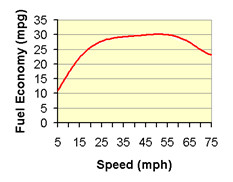 Just a public service announcement: speeding wastes gas. In fact, as the graph to the right shows, the typical car engine is most efficient at speeds of about 50 miles per hour (about 80 kph). Well, really there’s a broad plateau from about 30 mph/50 kph to about 55 mph/90 kph. Outside that plateau, though, fuel efficiency drops off substantially.
Just a public service announcement: speeding wastes gas. In fact, as the graph to the right shows, the typical car engine is most efficient at speeds of about 50 miles per hour (about 80 kph). Well, really there’s a broad plateau from about 30 mph/50 kph to about 55 mph/90 kph. Outside that plateau, though, fuel efficiency drops off substantially.
The problem is that highway traffic tends to move substantially faster than the point of maximum efficiency. Even if you wanted to save gas by, say, driving at 50 mph on the freeway, you might not feel safe among all the speedsters and tailgaters. And your feelings would probably be accurate; although the relationship between speed and safety can be pretty complicated, the evidence suggests that driving significantly slower (or faster) than the average traffic speed is a good way to get in a collision. Which in turn suggests that the way our highways are engineered may force drivers to make a choice between saving a bit of fuel and saving their lives.
The question, then, is what can we do about all that? Is there an easy way to keep traffic moving at the “sweet spot” — where considerations of travel time, fuel efficiency, and traffic safety are all in a reasonably optimal range? Any way to make the fuel-efficient choice the safe one?
The obvious answers — reducing posted speed limits and ramping up enforcement against speeders — may do some good. That said, there’s quite a bit of contrarian research (see here for examples) on the subject, claiming that faster speed limits don’t affect road safety — in part because faster roads pull more drivers off of dangerous rural highways and onto better-engineered freeways. Still, the bulk of the studies (see, e.g., this fairly comprehensive review) found that when the U.S. speed limit was raised from 55 mph to 65 mph, traffic fatalities increased.
But one problem is that posting lower speed limits doesn’t seem to change actual driving speeds that much. Look, for example, at this chart based on data from a 1997 study (big PDF download), showing that changes in the posted speed limit (the horizontal axis) had little effect on typical road speeds (the vertical axis).

Similarly, early assessments of the effects of raising highway speed limits from 55 mph to 65 mph in the U.S. suggested that travel speeds went up by only a few miles per hour — so reducing posted speed limits might decrease highway speeds a bit, but perhaps not enough for a driver to feel safe driving in the “sweet spot” for fuel efficiency.
So what about reducing highway speeds though a combination of lower speed limits and more aggressive enforcement? That might work. The contrarian view says that enforcement mechanisms such as traffic cameras are correlated with higher rates of accidents and injuries; but a closer look at the original study (PDF) convinces me that this is bunk: speed enforcement cameras were simply used on particularly risky stretches of road. So a combination of lower speed limits and tighter enforcement on heavily travelled sections of highway might be a good way of killing (or perhaps saving) two birds with one stone.


